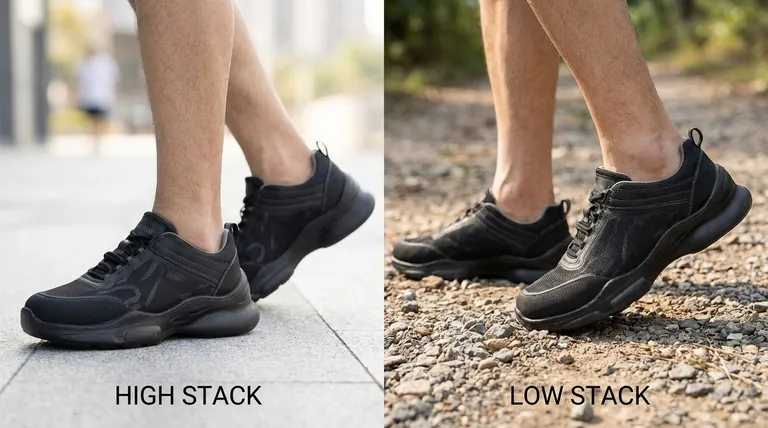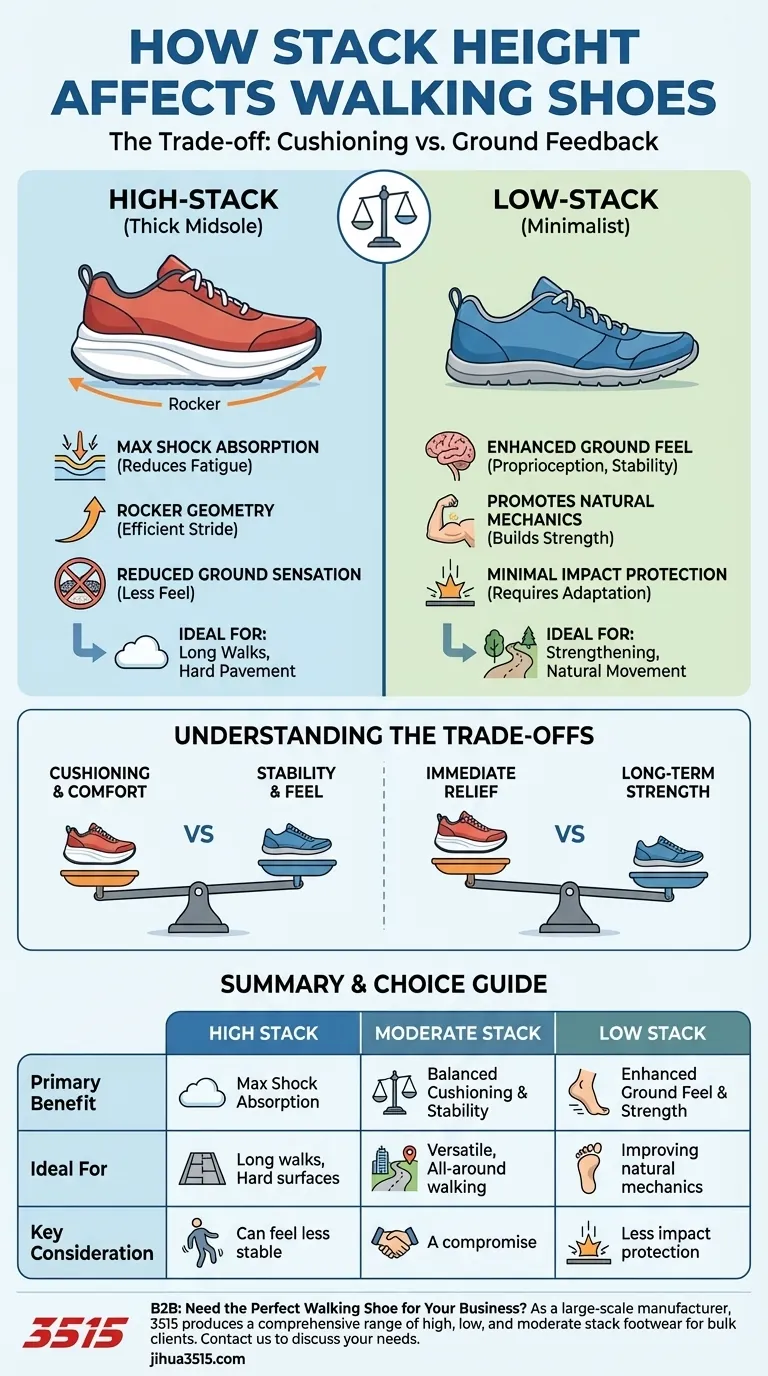In walking shoes, stack height fundamentally dictates the trade-off between cushioning and ground feedback. A higher stack height uses a thick midsole to maximize shock absorption, making it ideal for long walks on hard surfaces like pavement. Conversely, a lower stack height features a thinner sole that provides a more natural, connected-to-the-ground feel but offers significantly less impact protection.
Choosing the right stack height isn't about finding the single "best" shoe. It's about aligning the shoe's cushioning and stability profile with your specific walking environment, duration, and personal biomechanics.

The Role of High-Stack Shoes
High-stack shoes are defined by their thick, cushioned midsoles. This design philosophy prioritizes comfort and impact reduction above all else.
Maximizing Shock Absorption
The primary benefit of a thick midsole is its ability to absorb impact forces. Each step you take on a hard surface sends shock up through your body.
A taller stack of foam compresses upon landing, dissipating that force before it reaches your ankles, knees, and hips. This can reduce fatigue and soreness, especially over long distances.
The Effect on Gait
Many high-stack shoes incorporate a "rocker" geometry. The sole is curved, helping your foot roll smoothly from heel to toe.
This design can make your stride feel more efficient and less strenuous, as it guides your momentum forward with less effort from your feet and ankles.
Reduced Ground Sensation
The significant cushioning insulates your feet from the ground. While this enhances comfort, it also means you feel less of the texture and nuance of the surface you're walking on.
The Case for Low-Stack Shoes
Low-stack, or minimalist, shoes operate on the opposite principle. They aim to interfere with your natural foot movement as little as possible.
Enhancing Ground Feel
A thin sole provides direct feedback from the ground. This sensory information, known as proprioception, helps your brain and nervous system make micro-adjustments for better balance and stability.
Promoting Natural Foot Mechanics
With less material underfoot, your foot can bend and flex more naturally. This encourages the small, intrinsic muscles within your feet to engage and work harder.
Over time, this can lead to increased foot strength and a more stable foundation for your entire body.
Understanding the Trade-offs
Neither high nor low stack height is inherently superior; each comes with a distinct set of compromises that you must consider.
Cushioning vs. Stability
While high-stack shoes protect your joints, their height can sometimes create a feeling of instability, almost like walking on soft platforms.
Low-stack shoes are inherently more stable because your foot is closer to the ground, but they offer minimal protection from the repetitive impact of hard surfaces.
Comfort vs. Foot Strength
High-stack shoes provide immediate, out-of-the-box comfort. However, by doing so much of the work, they may not encourage your feet to build their own strength.
Low-stack shoes demand more from your body and often require an adaptation period. The long-term benefit can be stronger feet, but the short-term experience can be jarring without a gradual transition.
Making the Right Choice for Your Walk
To select the best stack height, consider the primary purpose and environment of your walking.
- If your primary focus is maximum comfort on long walks or hard surfaces: A high-stack shoe will provide the cushioning needed to protect your joints from repetitive impact.
- If your primary focus is strengthening your feet and improving natural mechanics: A low-stack shoe will enhance ground feel and allow your foot muscles to engage more fully.
- If you need a versatile, all-around option for mixed conditions: A moderate-stack shoe offers a balanced compromise, providing adequate cushioning for comfort with enough ground feel for stability.
Ultimately, the right shoe supports your personal biomechanics and makes walking feel comfortable and sustainable for your goals.
Summary Table:
| Stack Height | Primary Benefit | Ideal For | Key Consideration |
|---|---|---|---|
| High | Maximum shock absorption | Long walks on hard surfaces (pavement) | Can feel less stable; reduces ground feel |
| Low | Enhanced ground feel & foot strength | Improving natural foot mechanics | Less impact protection; requires adaptation |
| Moderate | Balanced cushioning & stability | Versatile, all-around walking | A compromise between high and low benefits |
Need the Perfect Walking Shoe for Your Business?
As a large-scale manufacturer, 3515 produces a comprehensive range of footwear for distributors, brand owners, and bulk clients. Whether your customers need high-stack shoes for maximum comfort or low-stack options for natural movement, our production capabilities encompass all types of shoes and boots.
Contact 3515 today to discuss your specific needs and let us help you deliver the ideal walking experience to your market.
Visual Guide

Related Products
- Wholesale Breathable Training Shoes Custom Athletic Footwear Manufacturer
- Lightweight Breathable Training Shoes for Wholesale & Custom OEM Manufacturing
- Durable Rubber-Soled Utility Shoes for Wholesale & Custom Brand Manufacturing
- Wholesale Lightweight Cushioned Athletic Sneakers for Custom Bulk Production
- Premium KPU Athletic Safety Shoes for Wholesale
People Also Ask
- What materials are best for athletic activities in warm climates? Stay Cool with Moisture-Wicking Fabrics
- Why are running shoes and walking shoes not interchangeable? Avoid Injury with the Right Footwear
- What should be considered when choosing smart trainers for business casual? A Guide to Professional Style
- What are the benefits of breathable materials in work shoes? Enhance Comfort & Health for Your Workforce
- How do athletic shoes with non-slip features differ from regular ones? Discover the Grip Advantage



















